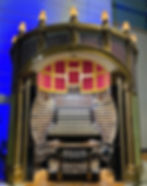About the Midmer-Losh
The Largest Musical Instrument on Earth

The History
The organ in the Main Auditorium of Jim Whelan Boardwalk Hall (formerly Convention Hall) was built by the Midmer-Losh Co., of Merrick, Long Island, New York. Work on the instrument, Opus 5550, started in May of 1929 and was completed in December, 1932. Often described as “The Sonic Mt. Rushmore,” the specifications were drawn-up by Emerson L. Richards (1884–1963), a native of Atlantic City and State Senator for Atlantic County. Although politics was his profession, pipe organs were his passion and pre-occupation. He described himself as an "Organ Architect" and, over the years, had some 80 articles published in organ journals. As a result of his design ideas and the practical demonstrations thereof, his influence extended far beyond Atlantic City, and he was dubbed "the Commander-in-Chief of the American Revolution in Organ Building" and is very much responsible (among other things) for what was to become the "organ reform" and "American Classic" movements of the 20th century.
The Main Auditorium is a vast space, over 14.6 million cubic feet of enclosed air space on an enclosed area of about 7 acres. The interior dimensions of the building are 456 feet long, 310 feet wide, and 137 feet high. To fill the venue with sound, Richards designed an organ with some mind-boggling and previously unheard of specifications. There are ten 32-foot ranks, the world's only 64-foot Diaphone (there only two 64' stops in the world, this being by far the largest) and four voices on 100" of air wind (double that of any other organ ever constructed). With an official total of 33,112 pipes, the organ is the largest (and loudest!) musical instrument on Earth. Although it has not functioned fully since the great Atlantic hurricane of 1944, it still continued to play for conventions, the Miss America Pageant, political rallies and sports events.
When ownership of the building was transferred to the New Jersey Sports and Exposition Authority (NJSEA) in 1992, the entire hall had fallen into considerable disrepair. The organ had not been fully operational since the mid-1970s, a period of inactivity that resulted in increasing deterioration, but interest in the organs was kept alive through the advocacy efforts of a non-profit organization, the Atlantic City Convention Hall Organ Society (ACCHOS).
In the late 1990s NJSEA initiated a tax-credit certified, one-hundred-million dollar interior restoration, that secured a 2003 National Trust for Historic Preservation Award and made Boardwalk Hall Billboard magazine’s top-performing mid-size arena in the United States in 2003 and 2004. NJSEA then retained the services of historic preservation and organ consultants to develop a fifteen-year Midmer-Losh organ restoration master plan and formed a non-profit 501c3 entity, the Historic Organs Restoration Committee, Inc., to serve as a stewardship advisory board.
The Historic Organ Restoration Committee is now overseeing the restoration of both organs of Historic Boardwalk Hall. The work of the past twelve years has brought about 95% of the 4/55 Ballroom Kimball back to life and approximately 60% of the 7/449 Midmer-Losh to functionality. At our current rate of funding, project completion is anticipated for 2030. If we continue to receive such generous public support, it is possible the instrument may be completed even sooner.
The pipes are accommodated in eight chambers arranged in opposite pairs on the left and right sides of the auditorium – there being four chambers in the stage area and four near the center of the room.
The main console is located to the right of the stage, near the proscenium arch. Its seven manuals are called, from bottom to top: Choir, Great, Swell, Solo, Fanfare, Echo, Bombard. There are 1,235 stop-keys, consisting of 852 speaking registers, 35 melodic percussions, 46 non-melodic percussions, 18 tremolos, 164 couplers, and 120 swell pedal selectives – for switching the shades of the swell boxes onto the six swell pedals (a seventh pedal is the crescendo).












